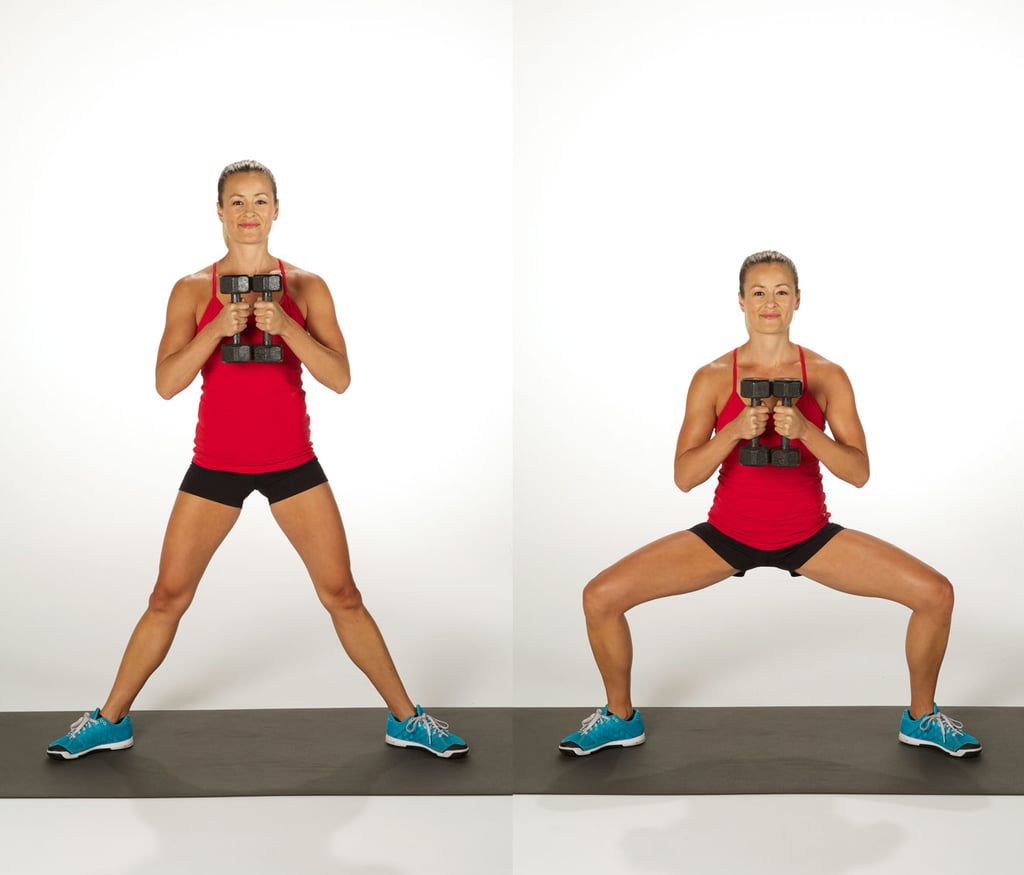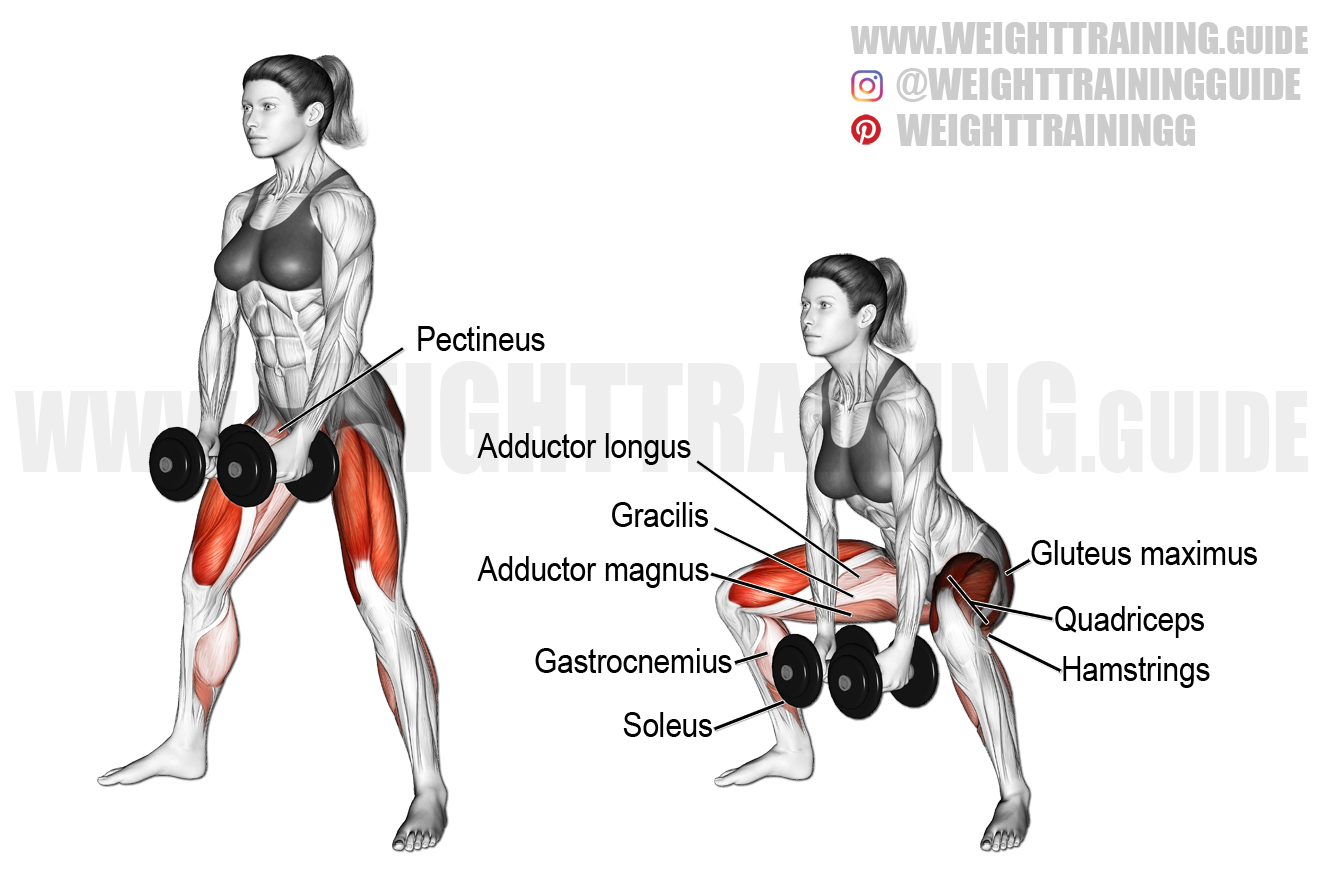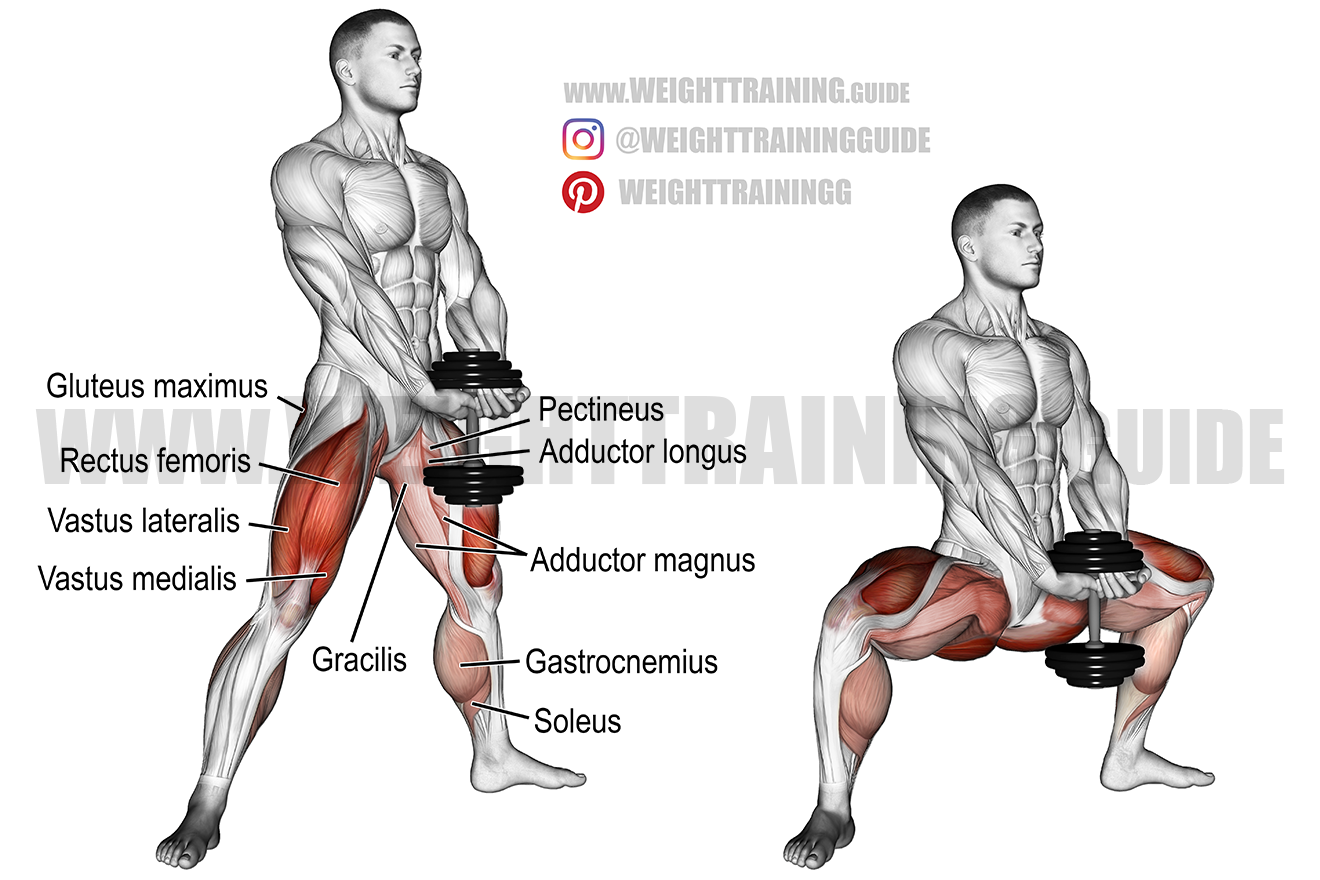Are you ready to truly change your home workouts with a very useful and effective piece of equipment, the dumbbell? For many people, dumbbells are convenient and adaptable, you know. They can be tucked away anywhere, which is pretty handy if your living space is a bit small.
Whether you're just starting your fitness journey or you've been exercising for a long time, these free weights offer a lot of possibilities. A good set of dumbbells, used individually or in pairs, is something many folks consider a must-have for any home fitness setup. They can really make your routine more intense, actually.
This article is all about the dumbbell sumo squat, a fantastic exercise that lets you take some pressure off your back while really working those leg muscles. It's a way to transform your leg workout, and we'll show you how to do it right, along with why it's so good for you. You'll find out why this move is quite popular for building lower body strength.
Table of Contents
- What is a Dumbbell Sumo Squat?
- Why Choose the Dumbbell Sumo Squat? (Benefits)
- Muscles Engaged: A Full Body Connection
- How to Perform the Dumbbell Sumo Squat Correctly
- Starting Position
- The Descent
- The Ascent
- Important Form Tips
- Variations to Keep Things Interesting
- Common Mistakes to Avoid
- Integrating the Dumbbell Sumo Squat into Your Routine
- Frequently Asked Questions About the Dumbbell Sumo Squat
What is a Dumbbell Sumo Squat?
The dumbbell sumo squat is a special kind of squat that stands apart from the usual version. It gets its name from the wide stance that sumo wrestlers often use, which is a bit different from how you'd normally stand. This wider foot placement changes which muscles get the most attention during the exercise, too.
Instead of holding the weight on your back, like with a barbell, you hold a dumbbell down between your legs. This shift in weight placement is a key part of why it feels different and works your body in a slightly new way. It's a very effective move for your leg day, helping you put the focus on certain muscles rather than stressing your back as much.
Essentially, this exercise is a variation that adds a challenge and brings a fresh feel to your regular squat routine. It's a compound movement, meaning it uses several muscle groups all at once throughout each repetition. This makes it quite efficient for building strength across your lower body, so it's a good choice for many people.
Why Choose the Dumbbell Sumo Squat? (Benefits)
There are many good reasons to include the dumbbell sumo squat in your exercise plan, you know. One of the main advantages is how it lets you shift the weight away from your back. For some, traditional squats can feel hard on the spine, but holding the dumbbell between your legs often feels more comfortable and safe, which is pretty important.
This exercise is also fantastic for really targeting specific muscle groups in your legs that might not get as much attention with other moves. It's an excellent way to give your quadriceps a thorough workout, and it also works your glutes and inner thigh muscles, or adductors, quite well. This makes it a comprehensive choice for building lower body strength and shape.
Plus, dumbbells are incredibly convenient for home workouts, as a matter of fact. They're easy to store and don't take up much room, making them a great option if your space is limited. Adding a set of hand weights to your routine, even if you're just a daily walker, can seriously increase the resistance and the intensity of your workout, you see.
This squat variation can also help address muscular imbalances. Because it puts a lot of focus on the inner thighs and glutes, it can help strengthen areas that might be weaker compared to your outer thigh muscles. This can lead to better overall leg strength and stability, which is quite useful for daily movements and other exercises, too.
It's also a very adaptable exercise. You can use a single dumbbell, or even two held together, to adjust the weight as you get stronger. This means it can grow with you as your fitness level improves, from a beginner just starting out to a seasoned athlete looking for new challenges, so it's a versatile choice for many.
Muscles Engaged: A Full Body Connection
The dumbbell sumo squat is a truly effective exercise because it calls upon a number of different muscle groups to work together. It primarily targets your quadriceps, which are the large muscles at the front of your thighs. These muscles do a lot of the work when you lower yourself down and push back up, you know.
Beyond the quads, this movement also heavily involves your hamstrings, which are at the back of your thighs. They help with the bending and straightening of your knees. Your glutes, or the muscles in your backside, also get a very good workout, especially as you push through your heels to stand back up, as a matter of fact.
What makes the sumo squat unique is its focus on the adductors, which are your inner thigh muscles. Because of the wide stance, these muscles have to work harder to stabilize your body and help with the movement. This can be a great benefit for strengthening an area that might sometimes be overlooked in other leg exercises, you see.
Your calves also play a part, helping with stability throughout the movement. And perhaps surprisingly, your erector spinae, which are the muscles along your spine, are also engaged. They work to keep your back straight and supported during the squat, which is pretty important for maintaining good form, too. So, it's a very comprehensive lower body exercise.
How to Perform the Dumbbell Sumo Squat Correctly
Learning the correct technique for the dumbbell sumo squat is key to getting the most out of it and staying safe. It's not too complicated, but paying attention to the details makes a big difference. Here’s a step-by-step guide to help you perform it well, you know.
Starting Position
First, stand with your feet much wider than your shoulders. This is the "sumo" part of the squat, and it's quite important. Your toes should point outwards, maybe at about a 45-degree angle, or even a bit more, depending on what feels comfortable for your hips, actually. This wide stance helps to open up your hips and engage those inner thigh muscles.
Next, pick up a dumbbell. Hold it vertically with both hands, letting it hang down in front of you between your legs. Your arms should be extended, but not locked out, so it's a relaxed grip. Your chest should be up, and your shoulders pulled back and down. Keep your gaze forward, too, which helps with balance and posture.
The Descent
Now, take a deep breath and begin to lower your body by bending at your knees and hips. Imagine you are sitting back into a chair that is placed behind you. Keep your back straight throughout this movement, which is pretty important. Your chest should stay lifted, and your shoulders should not round forward, you see.
As you go down, the dumbbell should stay close to your body, moving directly downwards between your legs. Make sure your knees track in the same direction as your toes; they should not collapse inwards. Go down until your thighs are roughly parallel to the floor, or as far as you can comfortably go while keeping good form. This might be a little challenging at first, but you'll get there.
The Ascent
Once you reach the bottom of the squat, push through your heels and the outer edges of your feet to stand back up. Really focus on squeezing your glutes and inner thighs as you come up. This helps activate those muscles effectively. Keep your core tight throughout the entire movement, too, as this helps stabilize your body.
Stand all the way up, fully extending your hips and knees at the top. Don't lock your knees out too hard, though; keep a very slight bend. This completes one repetition. You'll probably feel a good burn in your legs, especially your inner thighs, which is a sign you're doing it right, as a matter of fact.
Important Form Tips
To make sure you're doing the dumbbell sumo squat as effectively as possible, here are a few extra tips. Always warm up your body before starting your sets. This helps prepare your muscles and joints for the work ahead, so it's a good habit to have.
Keep your core engaged throughout the whole exercise. This means pulling your belly button towards your spine, which helps protect your lower back and keeps your body stable. A strong core is pretty much essential for any squat variation, you know.
Don't let your knees cave inwards. If they do, it might mean your stance is too wide, or your inner thighs need more strength. You could try a slightly narrower stance or use a lighter weight until your strength improves. Form is always more important than how much weight you lift, actually.
Breathe properly. Inhale as you lower down, and exhale as you push back up. This helps with oxygen flow to your muscles and maintains pressure in your core. It's a simple thing, but it makes a big difference in how you feel during the exercise, you see.
Variations to Keep Things Interesting
While the standard dumbbell sumo squat is very effective, there are many interesting ways you can perform it to add variety to your workouts. Changing things up can keep your muscles guessing and prevent boredom, which is pretty nice, you know. Here are a few ideas to consider.
One simple variation is the dumbbell sumo squat with a pulse. At the bottom of your squat, instead of coming all the way up, you just do a small, short movement up and down a few inches before fully standing. This adds extra time under tension for your muscles, making them work harder, as a matter of fact.
You could also try a dumbbell sumo squat with a heel raise at the top. As you stand up from the squat, lift your heels off the ground, coming up onto the balls of your feet. This adds a calf exercise to the movement, giving you a bit more work for your lower legs, you see. It also challenges your balance a little bit more.
For an added challenge, consider a dumbbell sumo squat to bicep curl. As you stand up from the squat, perform a bicep curl with the dumbbell you're holding. This turns it into a more compound, full-body movement, working your arms at the same time as your legs. It’s a good way to get more out of each repetition, too.
If you have two dumbbells, you could try holding one in each hand, with your arms extended down. This can sometimes feel more balanced for some people and allows for a bit more weight if you're ready for it. Just make sure you can maintain good form with both weights, which is pretty important.
Common Mistakes to Avoid
Even with a seemingly simple exercise like the dumbbell sumo squat, it's easy to fall into some common pitfalls. Being aware of these can help you stay safe and get the best results from your efforts. Avoiding these mistakes will make your workouts much more effective, you know.
One frequent error is letting your back round. This puts unnecessary stress on your spine and can lead to discomfort or even injury. Always keep your chest up and your back straight throughout the movement. Imagine there's a string pulling your head towards the ceiling, which helps keep your posture upright, as a matter of fact.
Another mistake is allowing your knees to collapse inwards. As mentioned earlier, your knees should track in line with your toes. If they start to buckle, it might mean the weight is too heavy, or your inner thigh muscles need more strength. Try reducing the weight or focusing on really pushing your knees outwards as you descend, you see.
Not going deep enough in the squat is another common issue. To truly work the target muscles, especially the glutes and inner thighs, you need to reach a good depth. Aim for your thighs to be parallel to the floor, if your mobility allows. If you can't go that deep with good form, that's okay; just go as far as you can while maintaining proper alignment, which is pretty important.
Holding your breath can also be a problem. Holding your breath can increase blood pressure and make you feel lightheaded. Remember to breathe in as you lower and breathe out as you push up. This rhythmic breathing helps you maintain control and provides your muscles with the oxygen they need, too.
Finally, using too much weight too soon is a mistake many people make. It's tempting to lift heavy, but sacrificing form for weight is never a good idea. Start with a lighter dumbbell to perfect your technique, then gradually increase the weight as you get stronger. This approach helps prevent injury and builds a solid foundation, so it's a smart way to go.
Integrating the Dumbbell Sumo Squat into Your Routine
Adding the dumbbell sumo squat to your regular exercise plan is a straightforward process, and it can really round out your leg workouts. Since it's a compound movement, it's a good idea to place it earlier in your routine when you have the most energy, you know. This allows you to perform it with better form and more intensity.
For beginners, starting with 2-3 sets of 8-12 repetitions is a solid approach. Focus on mastering the form before trying to increase the weight or the number of reps. You might do this exercise two or three times a week, allowing a day of rest in between for your muscles to recover, which is pretty important for growth, as a matter of fact.
If you're a seasoned athlete, you can use the dumbbell sumo squat as a warm-up, a main lift, or even as part of a superset with another leg exercise. You could also increase the weight or the number of sets and reps to challenge yourself further. It’s a very adaptable exercise that fits into many different training styles, you see.
Consider pairing it with other dumbbell exercises for a complete home workout. For instance, after your sumo squats, you could do dumbbell lunges or Romanian deadlifts to hit your legs from different angles. Remember, a set of the best dumbbells can vastly improve any home gym setup. They're great for both upper and lower body exercises, and they can help address muscular imbalances, too. Learn more about on our site for more workout ideas.
To get the most out of your dumbbells, it's helpful to understand how they were evaluated by experts. Things like ease of use, how simple they are to set up, how adjustable they are, the grip quality, how durable they are, how easy they are to store, and their overall value are all important considerations when choosing your own set. This helps you pick the right tools for your fitness goals, which is pretty useful.
This exercise can be a core part of your leg day, helping you achieve stronger, more defined legs without needing a lot of fancy equipment. It's a simple yet powerful addition to any home fitness plan, so give it a try. For more detailed tutorials on various exercises, you can link to this page .
Frequently Asked Questions About the Dumbbell Sumo Squat
What muscles does a dumbbell sumo squat primarily work?
The dumbbell sumo squat really targets your quadriceps, hamstrings, glutes, and especially your inner thigh muscles, known as adductors. It also uses your calves and the muscles supporting your spine, which is pretty comprehensive, you know.
Is a sumo squat better than a regular squat?
Neither is necessarily "better"; they just offer different benefits. The sumo squat with a dumbbell shifts the focus more to your inner thighs and glutes and can be easier on your back. A regular squat often works your quads and glutes more evenly. It really depends on your goals and what feels good for your body, as a matter of fact.
How heavy should I dumbbell sumo squat?
Start with a weight that allows you to maintain perfect form for 8-12 repetitions. If your form starts to break down, the weight is too heavy. It's always better to use a lighter weight with good technique than a heavy one with poor form, which is pretty important. You can gradually increase the weight as you get stronger, too.



Detail Author:
- Name : Anne Fadel
- Username : macejkovic.colleen
- Email : jconsidine@yahoo.com
- Birthdate : 1989-09-04
- Address : 8547 Abel Plains Apt. 959 Eichmannfort, OK 46104-8740
- Phone : 1-347-445-2337
- Company : Cummings, Dietrich and Beer
- Job : Marketing Manager
- Bio : Explicabo vel repudiandae officia nisi id nihil. Dolore et eius blanditiis laborum. Et dignissimos vel ad et. Quam sed quasi consequuntur libero eaque. Est accusantium velit sed non culpa ut.
Socials
instagram:
- url : https://instagram.com/imani1458
- username : imani1458
- bio : Quaerat est ea itaque ut. Et vel itaque sunt repellat nisi aut. Voluptatum quia odit quasi.
- followers : 3655
- following : 1205
twitter:
- url : https://twitter.com/imani_xx
- username : imani_xx
- bio : Ex ut itaque totam aliquid repellat qui impedit. Ex tenetur reiciendis quo esse nostrum qui. At officia ea est modi.
- followers : 1133
- following : 2892
facebook:
- url : https://facebook.com/iskiles
- username : iskiles
- bio : Cum magni autem quia voluptatum.
- followers : 2462
- following : 2636



























